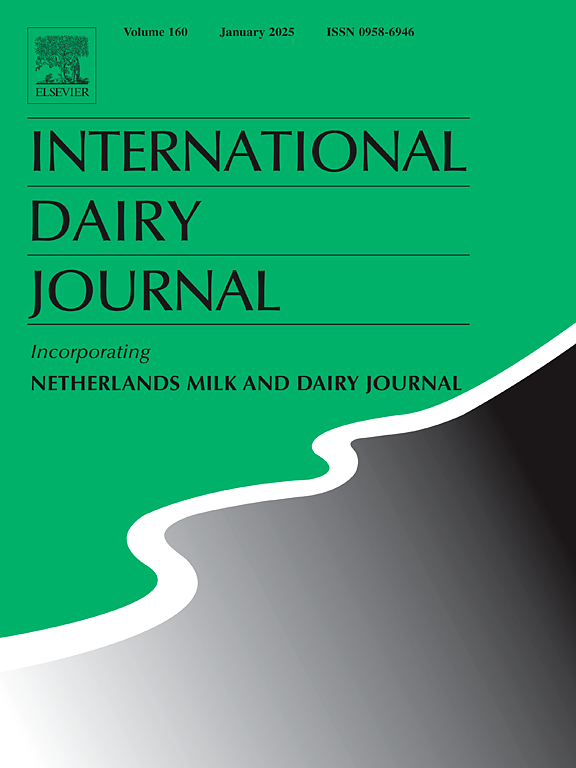重组酶辅助扩增结合凝集素-磁分离检测食品中金黄色葡萄球菌
IF 3.4
3区 农林科学
Q2 FOOD SCIENCE & TECHNOLOGY
引用次数: 0
摘要
在被污染的食品中,金黄色葡萄球菌可产生肠道毒素,引起多种疾病,对人类健康构成威胁,因此建立一种快速、准确的金黄色葡萄球菌检测方法具有重要意义。本研究采用重组酶辅助扩增(RAA)和凝集素磁分离(LMS)相结合的方法检测脱脂牛奶和桃汁中的金黄色葡萄球菌。利用傅里叶变换红外光谱仪表征链霉亲和素共轭磁珠(MBs-SA)对金黄色葡萄球菌进行捕获。通过扫描电镜验证了LMS策略捕获金黄色葡萄球菌的性能,并获得了不同浓度细菌的捕获效率。RAA-LMS检测金黄色葡萄球菌的检出限(LOD)为纯培养3.6 × 101 CFU/mL,加标脱脂牛奶4.4 × 105 CFU/mL,加标果汁1.15 × 103 CFU/mL。与PCR-LMS法相比,RAA-LMS法的LOD较低,灵敏度提高了3个数量级。同时,该方法的检测时间比标准培养法短。综上所述,所建立的RAA-LMS法具有快速、准确检测金黄色葡萄球菌的潜力。本文章由计算机程序翻译,如有差异,请以英文原文为准。
Recombinase aided amplification combined with lectin-magnetic separation for detection of Staphylococcus aureus in food samples
In contaminated food, Staphylococcus aureus is a threat to human health because it can produce enterotoxins and cause various diseases, therefore, it is important to establish a fast, accurate method to detect S. aureus. In our study, recombinase aided amplification (RAA) combined with lectin-magnetic separation (LMS) was applied to detect S. aureus in skim milk and peach juice. The streptavidin-conjugated magnetic beads (MBs-SA) characterized by Fourier Transform Infrared Spectrometer was used to capture S. aureus. The performance of LMS strategy to capture S. aureus was verified by scanning electron microscope and capture efficiency was obtained in various concentrations of bacteria. The limit of detection (LOD) of this RAA-LMS assay for S. aureus was 3.6 × 101 CFU/mL in pure culture, 4.4 × 105 CFU/mL in spiked skim milk and 1.15 × 103 CFU/mL in spiked juice. Compared with PCR-LMS method, the LOD for RAA-LMS assay was lower, and its sensitivity was improved by three orders of magnitude. Moreover, the detection time of this RAA-LMS method was shorter than that of the standard cultural method. In conclusion, the proposed RAA-LMS assay had a great potential for the rapid and accurate detection of S. aureus.
求助全文
通过发布文献求助,成功后即可免费获取论文全文。
去求助
来源期刊

International Dairy Journal
工程技术-食品科技
CiteScore
6.50
自引率
9.70%
发文量
200
审稿时长
49 days
期刊介绍:
The International Dairy Journal publishes significant advancements in dairy science and technology in the form of research articles and critical reviews that are of relevance to the broader international dairy community. Within this scope, research on the science and technology of milk and dairy products and the nutritional and health aspects of dairy foods are included; the journal pays particular attention to applied research and its interface with the dairy industry.
The journal''s coverage includes the following, where directly applicable to dairy science and technology:
• Chemistry and physico-chemical properties of milk constituents
• Microbiology, food safety, enzymology, biotechnology
• Processing and engineering
• Emulsion science, food structure, and texture
• Raw material quality and effect on relevant products
• Flavour and off-flavour development
• Technological functionality and applications of dairy ingredients
• Sensory and consumer sciences
• Nutrition and substantiation of human health implications of milk components or dairy products
International Dairy Journal does not publish papers related to milk production, animal health and other aspects of on-farm milk production unless there is a clear relationship to dairy technology, human health or final product quality.
 求助内容:
求助内容: 应助结果提醒方式:
应助结果提醒方式:


